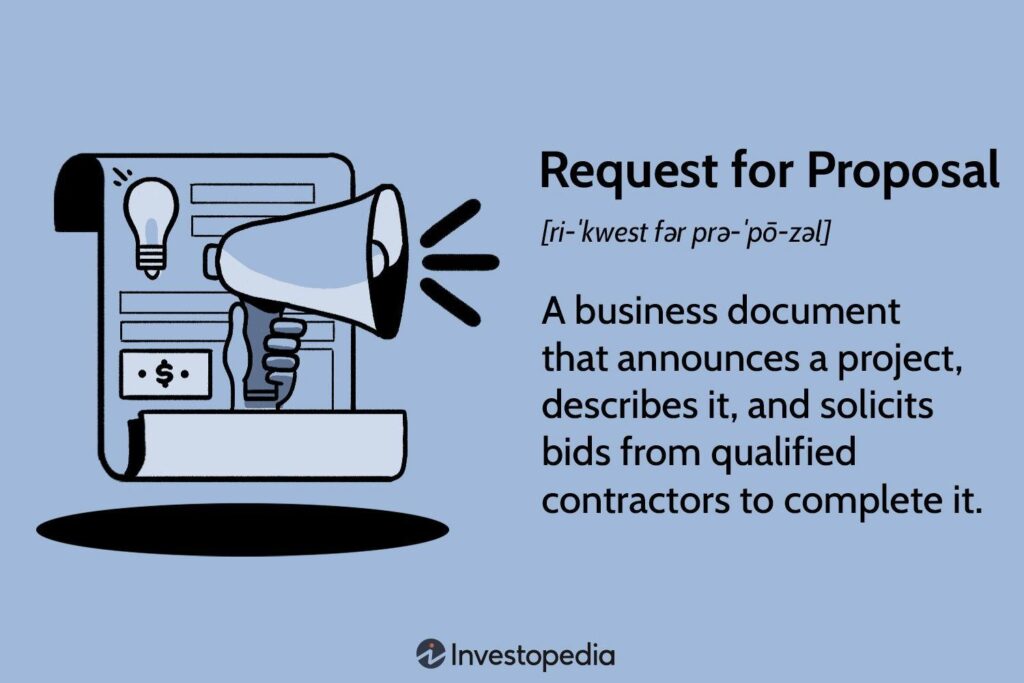What Is a Request for Proposal (RFP)?
Key Takeaways
Understanding a Request for Proposal (RFP)
Request for Proposal (RFP) in the construction industry is a document that outlines the scope of work, project requirements, and solicits proposals from potential contractors or suppliers. The primary goal of an RFP is to invite several vendors to submit competitive proposals to bid on a project. The RFP process helps ensure that the chosen vendor can deliver the project within the specified budget and timeline. RFPs are commonly used for complex projects, such as construction, where the requirements and scope of work may not be fully known or are subject to change during the project. An RFP allows the issuer to compare and evaluate proposals based on various criteria, including cost, technical expertise, and project approach.
Requirements for a RFP
When preparing a RFP , it’s crucial to include specific details about the project, such as the scope of work, project objectives, timeline, budget, evaluation criteria, and any special requirements. The RFP should also outline the submission process, including the deadline for proposals, the format for submissions, and any mandatory pre-bid meetings or site visits. A well-defined RFP also includes terms and conditions, project specifications, and any other relevant documents that vendors need to review before submitting their proposals. Clearly outlining these requirements helps ensure that all potential vendors have a complete understanding of the project’s expectations.
Benefits of a RFP
The use of an RFP offers several benefits for both the issuer and the vendors. For the issuer, an RFP allows for a competitive bidding process, which can result in competitive pricing and higher quality proposals. It also provides a structured approach to evaluating and selecting the best-suited vendor for the project. Vendors benefit from RFPs by gaining insight into the project requirements and expectations, which enables them to tailor their proposals to meet the specific needs of the project. Additionally, it allows vendors to showcase their expertise and differentiate themselves from competitors through their proposal submissions.
RFP vs. RFQ vs. RFI
In the construction industry, three common procurement processes are frequently used: Request for Proposal (RFP) , Request for Quote (RFQ) , and Request for Information (RFI) . While all three are used to solicit information from potential vendors, they serve different purposes. An RFQ is used when the project requirements are well-defined, and the issuer requires pricing information for specific products or services. An RFI , on the other hand, is used to gather information and establish a pool of potential vendors before initiating the RFP or RFQ process.
Example of a RFP
A Look at a Detailed RFP
Let’s take a closer look at an example of a detailed RFP . Suppose a construction company is planning to build a new office complex. The RFP for this project would include detailed information about the project’s scope, including architectural plans, site requirements, and expected timelines. It would also outline the evaluation criteria, such as previous experience, proposed project timelines, and cost. Here’s a summary of the content we’ve covered so far in this article:
| Section | Summary |
|---|---|
| Understanding RFP | Overview of RFP in construction and its primary purpose |
| RFP Requirements | Essential elements to include in an RFP for construction projects |
| Benefits of RFP | Advantages of using RFP for both issuers and vendors |
| RFP vs. RFQ vs. RFI | Comparison of different procurement processes in construction |
| RFP Example | A detailed example of an RFP for a construction project |
Frequently Asked Questions
What Does RFP Mean?
RFP stands for “Request for Proposal” in the construction industry. It is a document used to solicit proposals from potential contractors or suppliers for a specific project.
What Are RFP Requirements?
The RFP requirements typically include details about the project scope, objectives, timeline, budget, submission process, evaluation criteria, and any special requirements.
What Is the Difference Between RFP and RFQ?
The main difference between an RFP and an RFQ is that an RFP is used for projects with complex or evolving requirements, while an RFQ is used for projects with well-defined requirements where the issuer requires pricing information for specific products or services.
When Would You Use an RFP?
An RFP is typically used when the project requirements are not fully known, or there is a need for innovative solutions, and a competitive bidding process is desired to select the best-suited vendor for the project.
What Happens After the RFP?
After the submission of proposals in response to the RFP , the issuer evaluates the proposals based on the specified criteria and selects the vendor who best meets the project requirements.
The Bottom Line
In conclusion, a well-crafted RFP plays a critical role in the construction industry by facilitating a competitive bidding process, ensuring project requirements are met, and ultimately selecting the best vendor to deliver the project’s objectives. Understanding the purpose, requirements, and benefits of an RFP is essential for both issuers and vendors involved in construction projects.
FAQ
What is the difference between a RFI and RFP?
RFI (Request For Information) is a process of gathering information about capabilities of various suppliers, with the aim of developing a general strategy. RFP (Request For Proposal), on the other hand, is a business document detailing specifics about a project to get proposals from potential vendors. Essentially, RFI is for gathering information and RFP is for soliciting proposals.
What is difference between RFP and RFQ?
RFP (Request for Proposal) is used when a business requires a solution to a problem and invites suppliers to propose solutions, requiring a detailed plan. RFQ (Request for Quote) is used when a business knows what they need and wants suppliers to provide a cost estimate for delivering it, primarily focusing on the price.
What is RFP in project procurement?
A Request for Proposal (RFP) in project procurement is a document that solicits proposal, often made through a bidding process, by a company interested in procurement of a commodity, service, or valuable asset, to potential suppliers to submit business proposals. It provides details about the project and asks suppliers to provide a proposal on how they would execute the project.
What is RFP in design build?
RFP (Request for Proposal) in design build is a document that outlines project requirements and invites contractors and agencies to submit a proposal showcasing their solution, approach, timeline, and cost estimates for the project. It ensures that potential providers can propose a comprehensive design-build solution that aligns with the client’s objectives.


